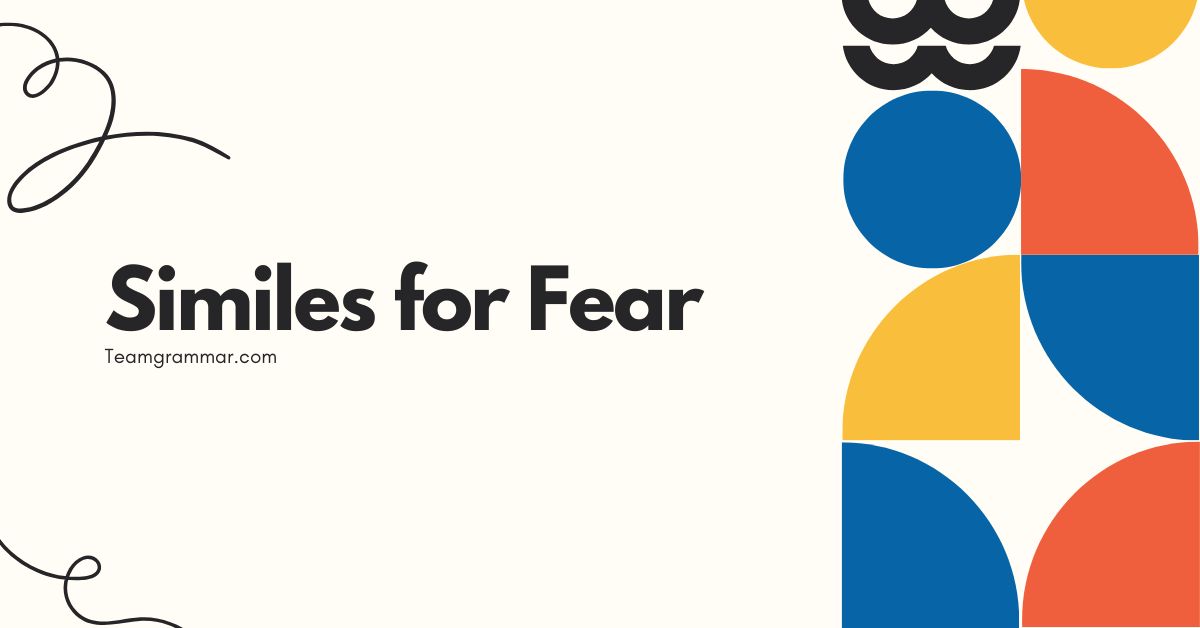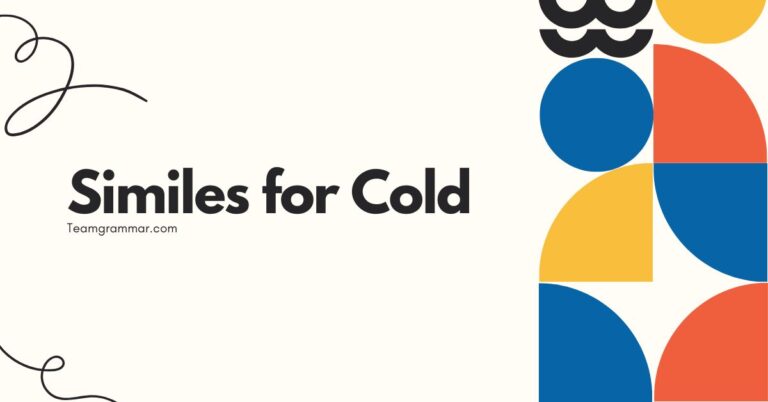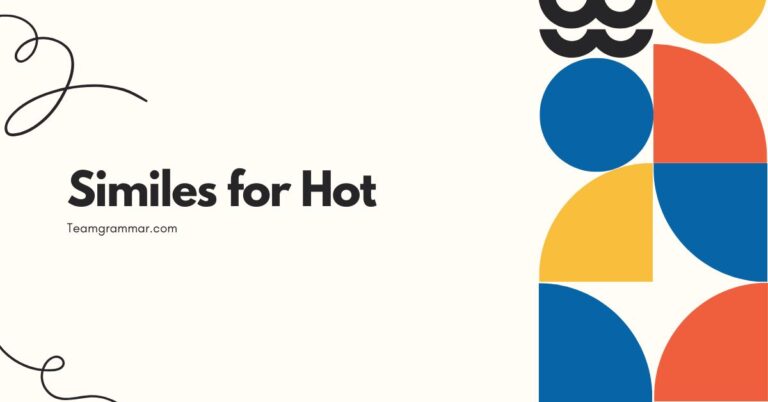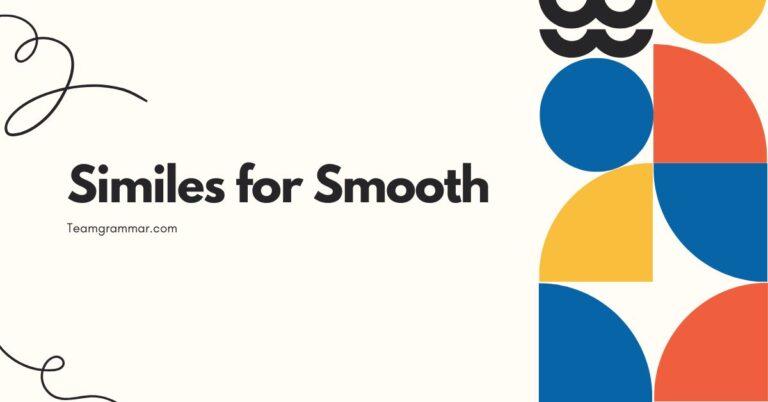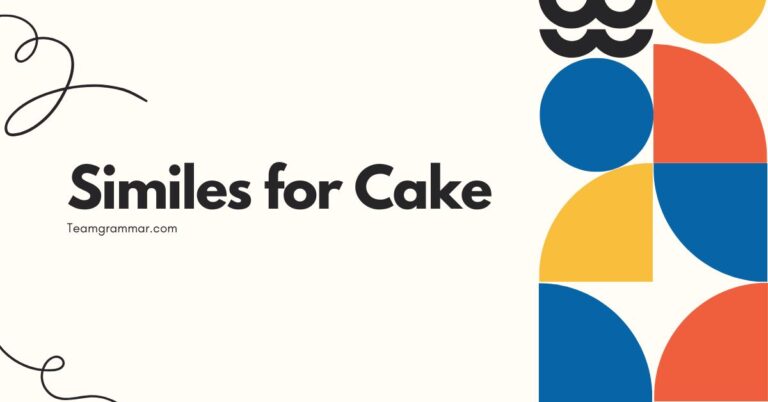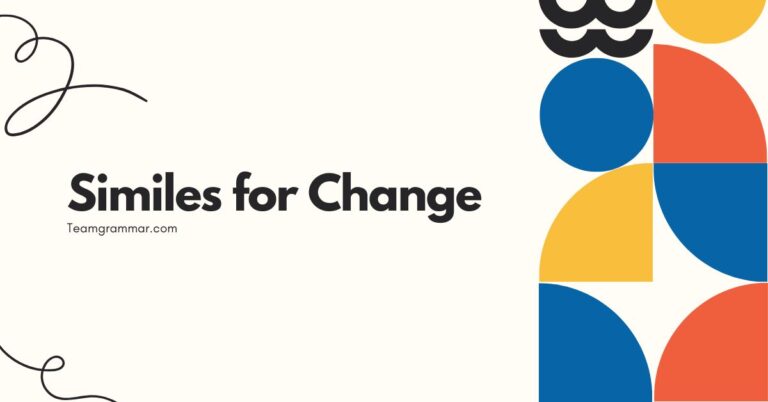31 Similes for Fear: Mastering Descriptive Language
Understanding how to effectively use similes to describe fear is crucial for enhancing your writing and communication skills. Similes allow you to create vivid and relatable images in the reader’s mind, making your descriptions more impactful and memorable.
This article provides a comprehensive guide to using similes for fear, covering various types, structural rules, and common mistakes. Whether you are a student, writer, or English language learner, this article will equip you with the knowledge and tools to master this important aspect of descriptive language.
Table of Contents
- 1. Definition of Simile for Fear
- 2. Structural Breakdown
- 3. Types of Similes for Fear
- 4. Examples of Similes for Fear
- 5. Usage Rules
- 6. Common Mistakes
- 7. Practice Exercises
- 8. Advanced Topics
- 9. FAQ
- 10. Conclusion
1. Definition of Simile for Fear
A simile is a figure of speech that compares two unlike things using the words “like” or “as.” The purpose of a simile is to create a vivid and relatable image in the reader’s mind by drawing a comparison between something familiar and something less so. When a simile is used to describe fear, it helps express the intensity, nature, or impact of the fear being experienced.
It allows the writer to convey the emotion in a more evocative and imaginative way, making it easier for the reader to connect with the described feeling.
In essence, a simile for fear takes the feeling of fear and equates it to something else that the reader can easily understand and visualize. This can involve comparing fear to a physical sensation, an animal’s behavior, or a natural phenomenon.
The key is that the comparison highlights a specific aspect of the fear, such as its suddenness, intensity, or paralyzing effect. For example, saying someone was “as pale as a ghost” conveys the physical manifestation of fear, while saying their heart was “beating like a drum” emphasizes the anxiety and nervousness associated with the emotion.
The function of similes for fear extends beyond simple description. It allows writers to explore the nuances of fear, capturing its complex and often contradictory nature.
A well-crafted simile can reveal the underlying causes of fear, the individual’s reaction to it, and the overall impact it has on their thoughts and actions. By using similes effectively, writers can create a more immersive and emotionally resonant experience for the reader, deepening their understanding of the character or situation being described.
2. Structural Breakdown
2.1 Key Elements
The basic structure of a simile consists of three key elements: the subject being described (in this case, fear), the comparison word (“like” or “as”), and the object or concept to which the subject is being compared. Understanding these elements is essential for creating effective and meaningful similes.
- Subject: The thing being described. This is usually a feeling, a person experiencing fear, or a situation causing fear.
- Comparison Word: The word “like” or “as” that connects the subject and the object of comparison.
- Object of Comparison: The thing to which the subject is being compared. This should be something that shares a common characteristic with the subject, making the comparison logical and understandable.
For example, in the simile “His hands were shaking like leaves,” the subject is “his hands,” the comparison word is “like,” and the object of comparison is “leaves.” The simile effectively conveys the trembling and instability caused by fear by comparing it to the shaking of leaves in the wind.
2.2 Common Patterns
While the basic structure of a simile remains consistent, there are several common patterns that writers use to create different effects. These patterns involve varying the order of the elements or adding descriptive details to enhance the comparison.
- Subject + Comparison Word + Object: This is the most common and straightforward pattern. Examples include: “Fear gripped him like ice,” “She was as quiet as a mouse.”
- As + Adjective + As + Object: This pattern emphasizes a particular quality or characteristic of the subject. Examples include: “As cold as ice,” “As pale as a ghost.”
- Object + Comparison Word + Subject: This pattern places emphasis on the object of comparison, drawing attention to its specific qualities. Examples include: “A deer in headlights, he stood frozen with fear.”
By understanding these patterns, writers can create a wider range of similes to express the nuances of fear more effectively. The choice of pattern depends on the specific aspect of fear that the writer wants to emphasize and the overall tone of the writing.
3. Types of Similes for Fear
Similes for fear can be categorized based on the aspect of fear they emphasize. These categories include physical reactions, emotional states, and situational fear.
By understanding these different types, writers can choose the most appropriate simile to convey the specific nuance of fear they want to express.
3.1 Physical Reactions
These similes describe the physical manifestations of fear, such as trembling, sweating, increased heart rate, and changes in skin color. They help the reader visualize the physical impact of fear on the body.
Examples include:
- His hands were shaking like leaves.
- Her heart was pounding like a drum.
- He was as pale as a ghost.
- His knees felt like jelly.
- Sweat poured down his face like a waterfall.
3.2 Emotional States
These similes describe the emotional aspects of fear, such as anxiety, panic, dread, and terror. They help the reader understand the internal experience of fear and its impact on the mind.
Examples include:
- Fear washed over her like a tidal wave.
- Panic seized him like a vise.
- Dread filled her heart like a dark cloud.
- He felt as helpless as a lamb before the slaughter.
- Her mind raced like a runaway train.
3.3 Situational Fear
These similes describe the situations or circumstances that cause fear. They help the reader understand the context of the fear and the specific triggers that elicit it.
Examples include:
- The silence was as thick as a tomb.
- The darkness was like a suffocating blanket.
- The unknown stretched before them like a vast, empty sea.
- The threat loomed like a shadow over their lives.
- He felt as trapped as a rat in a cage.
4. Examples of Similes for Fear
Here are some extensive examples of similes categorized by the aspect of fear they describe. These examples provide a wide range of options for expressing fear in different contexts and styles.
4.1 Physical Reactions Examples
The following table provides examples of similes that describe physical reactions to fear. These similes help the reader visualize the physical impact of fear on the body, making the description more vivid and relatable.
| Simile | Explanation |
|---|---|
| His hands were shaking like leaves in a storm. | Emphasizes the uncontrollable trembling caused by intense fear. |
| Her heart was pounding like a drum solo. | Highlights the rapid and forceful heartbeat associated with panic. |
| He was as pale as a ghost after seeing the accident. | Conveys the loss of color in the face due to shock and fear. |
| His knees felt like jelly when he had to speak in public. | Describes the weakness and instability in the legs caused by nervousness. |
| Sweat poured down her face like a waterfall during the interrogation. | Illustrates the excessive sweating resulting from anxiety and stress. |
| His breath hitched in his throat like a sob he couldn’t release. | Depicts the difficulty in breathing and suppressed emotion. |
| Her skin crawled like ants were marching beneath it. | Describes the unsettling sensation of goosebumps or a prickly feeling. |
| His voice cracked like a teenager’s during puberty, betraying his fear. | Shows how fear can affect vocal control. |
| He felt as cold as ice despite the summer heat. | Indicates the chilling effect of fear overriding physical temperature. |
| Her eyes widened like saucers when she saw the shadow. | Highlights the dilation of pupils due to surprise and fear. |
| His stomach twisted like a wet rag. | Describes the nauseous feeling caused by anxiety. |
| Her teeth chattered like castanets in the cold, dark room. | Illustrates the uncontrollable shivering due to fear. |
| He felt his blood run cold like ice water. | Conveys the sensation of extreme fear and shock. |
| His muscles were as tight as coiled springs. | Describes the tension and rigidity caused by fear. |
| Her hands were clammy like a frog’s skin. | Highlights the moist and cold feeling of hands due to nervousness. |
| He jumped like a startled cat at the sudden noise. | Illustrates the sudden and involuntary reaction to a frightening stimulus. |
| Her legs felt like lead weights, making it hard to run. | Describes the heavy and difficult feeling of legs due to fear. |
| His throat felt as dry as sandpaper. | Conveys the sensation of dryness in the throat due to anxiety. |
| He gasped for air like a fish out of water. | Illustrates the desperate need for oxygen during a panic attack. |
| Her body trembled like an earthquake. | Emphasizes the intense and uncontrollable shaking caused by extreme fear. |
| His vision blurred like looking through a foggy window. | Describes the effect of fear on eyesight. |
| Her face flushed as red as a beet with terror. | Illustrates the sudden reddening of the face due to fear. |
| He felt as weak as a kitten. | Conveys the feeling of helplessness and vulnerability. |
4.2 Emotional States Examples
The following table provides examples of similes that describe emotional states associated with fear. These similes help the reader understand the internal experience of fear and its impact on the mind.
| Simile | Explanation |
|---|---|
| Fear washed over her like a tidal wave, threatening to drown her. | Emphasizes the overwhelming and all-consuming nature of fear. |
| Panic seized him like a vise, squeezing the air from his lungs. | Highlights the constricting and suffocating feeling of panic. |
| Dread filled her heart like a dark cloud, obscuring all hope. | Conveys the heavy and oppressive feeling of impending doom. |
| He felt as helpless as a lamb before the slaughter, knowing his fate was sealed. | Describes the feeling of vulnerability and powerlessness in the face of danger. |
| Her mind raced like a runaway train, thoughts colliding and scattering. | Illustrates the chaotic and uncontrollable nature of anxious thoughts. |
| Anxiety gnawed at him like a rat, slowly eating away at his peace of mind. | Depicts the persistent and destructive nature of anxiety. |
| Terror gripped her like a frozen hand, paralyzing her with fear. | Highlights the immobilizing effect of extreme fear. |
| He felt as vulnerable as a newborn chick, exposed and defenseless. | Conveys the feeling of being unprotected and at risk. |
| Her hope dwindled like a candle in the wind, threatened by the darkness. | Describes the fading of hope in the face of fear and uncertainty. |
| He was as scared as a child lost in the woods, surrounded by shadows and unknowns. | Illustrates the feeling of disorientation and helplessness. |
| His courage melted like ice cream on a hot day. | Depicts the rapid disappearance of bravery in the face of fear. |
| She felt as fragile as a butterfly caught in a storm. | Conveys the feeling of being easily overwhelmed and destroyed. |
| His spirit sank like a stone into a deep, dark well. | Illustrates the feeling of despair and hopelessness. |
| She felt as if she was walking on eggshells, afraid to make a wrong move. | Describes the feeling of being constantly on edge and anxious. |
| His heart ached like a physical wound. | Conveys the intense emotional pain caused by fear. |
| She felt as isolated as a castaway on a deserted island. | Illustrates the feeling of loneliness and abandonment. |
| His fear was a constant companion, like a shadow that never left his side. | Depicts the persistent and inescapable nature of fear. |
| She felt as if she were drowning in a sea of anxiety. | Conveys the overwhelming and suffocating feeling of anxiety. |
| His mind was a battlefield, thoughts clashing like warring armies. | Illustrates the internal conflict and turmoil caused by fear. |
| He felt like a puppet on a string, controlled by his fear. | Describes the feeling of being powerless and manipulated by fear. |
| Her stomach was tied in knots like a pretzel. | Illustrates the physical manifestation of anxiety. |
| He felt as though he was walking through a nightmare. | Conveys the surreal and terrifying nature of fear. |
4.3 Situational Fear Examples
The following table provides examples of similes that describe situations or circumstances that cause fear. These similes help the reader understand the context of the fear and the specific triggers that elicit it.
| Simile | Explanation |
|---|---|
| The silence was as thick as a tomb, broken only by the sound of his own breathing. | Emphasizes the oppressive and unsettling nature of complete silence. |
| The darkness was like a suffocating blanket, enveloping him and stealing his breath. | Highlights the claustrophobic and disorienting effect of darkness. |
| The unknown stretched before them like a vast, empty sea, full of unseen dangers. | Conveys the feeling of uncertainty and apprehension about the future. |
| The threat loomed like a shadow over their lives, casting a pall of fear and uncertainty. | Depicts the constant presence of danger and its impact on their well-being. |
| He felt as trapped as a rat in a cage, with no escape from his impending doom. | Illustrates the feeling of confinement and hopelessness. |
| The storm raged like a beast, tearing at the house and threatening to devour them all. | Highlights the destructive and terrifying power of nature. |
| The haunted house stood like a silent sentinel, guarding its secrets and preying on the fears of those who dared to enter. | Conveys the eerie and ominous atmosphere of a haunted place. |
| The abandoned road stretched ahead like a ribbon of darkness, promising nothing but danger and despair. | Describes the foreboding and unsettling nature of a deserted place. |
| The interrogation room felt as cold as a morgue, devoid of warmth and compassion. | Illustrates the sterile and intimidating atmosphere of a place of questioning. |
| The crowded street felt like a maze, full of hidden threats and unseen dangers. | Conveys the feeling of being overwhelmed and vulnerable in a public space. |
| The forest was as dark as pitch. | Emphasizes the complete lack of light. |
| The creaking of the old house was like whispers from the dead. | Adds a supernatural element to the fear. |
| The silence after the scream was like the calm before a hurricane. | Creates suspense and anticipation of further danger. |
| The empty school hallways echoed like a haunted cathedral. | Illustrates the eeriness of an empty building. |
| The rollercoaster climbed as slowly as a condemned man walking to his execution. | Heightens the tension and anticipation of the drop. |
| The clown’s smile was as terrifying as a shark’s grin. | Subverts a normally harmless symbol to create fear. |
| The abandoned hospital loomed like a decaying monster. | Conveys the sense of decay and dread. |
| The dark alleyway was as inviting as a viper’s nest. | Illustrates the feeling of danger and threat. |
| The old doll’s eyes were as lifeless as a corpse’s. | Adds a creepy and unsettling element. |
| The carnival music was as sinister as a funeral dirge. | Subverts a normally cheerful sound to create fear. |
| The test felt like an execution. | Conveys the high level of anxiety felt by the test taker. |
| The interview felt like a trial by fire. | Describes the intense pressure and scrutiny of the interview. |
5. Usage Rules
While similes offer a creative way to express fear, it’s essential to use them correctly and appropriately. The usage rules vary depending on the context, style, and audience.
5.1 Formal Writing
In formal writing, such as academic papers or professional reports, similes should be used sparingly and with careful consideration. The comparisons should be clear, logical, and relevant to the topic.
Avoid using overly emotional or sensational similes, as they may detract from the objectivity and credibility of the writing.
Example:
Incorrect: “The economic crisis spread like a wildfire, consuming everything in its path.”
Correct: “The economic crisis spread rapidly, impacting various sectors like a chain reaction.”
5.2 Informal Writing
In informal writing, such as personal essays or blog posts, you have more freedom to use similes creatively and expressively. However, it’s still important to ensure that the comparisons are understandable and appropriate for your audience.
Avoid using offensive or insensitive similes.
Example:
Incorrect: “He was as scared as a mouse in a lion’s den, which was hilarious.”
Correct: “He was as scared as a mouse in a lion’s den, his eyes wide with panic.”
5.3 Creative Writing
In creative writing, such as novels or poems, similes can be used extensively to create vivid imagery and enhance the emotional impact of the writing. Experiment with different types of similes and patterns to find the most effective way to express fear.
Don’t be afraid to use unusual or unexpected comparisons, as long as they are meaningful and contribute to the overall tone and atmosphere of the writing.
Example:
“Fear coiled in her stomach like a serpent, its venom poisoning her thoughts and actions.”
6. Common Mistakes
Even experienced writers can make mistakes when using similes for fear. Being aware of these common errors can help you avoid them and improve the quality of your writing.
6.1 Using Cliches
Cliches are overused and unoriginal similes that have lost their impact. Avoid using cliches such as “as scared as a ghost” or “like a deer in headlights.” Instead, strive to create fresh and imaginative comparisons that will surprise and engage your readers.
Example:
Cliche: “He was as scared as a ghost.”
Improved: “He was as pale as moonlight, his eyes wide with terror.”
6.2 Inappropriate Comparisons
Avoid using similes that are offensive, insensitive, or irrelevant to the context. The comparison should be logical and appropriate for your audience.
Consider the potential impact of the simile on your readers and choose your words carefully.
Example:
Inappropriate: “He was as scared as a refugee fleeing their home.”
Improved: “He was as scared as someone facing an unknown danger.”
6.3 Misunderstandings of Simile Structure
Ensure that you understand the basic structure of a simile and use the words “like” or “as” correctly. Avoid using metaphors instead of similes, or creating comparisons that are illogical or confusing.
Example:
Incorrect: “Fear was a dark cloud.” (This is a metaphor)
Correct: “Fear was like a dark cloud, obscuring her vision.” (This is a simile)
7. Practice Exercises
These practice exercises will help you improve your ability to identify, complete, and create similes for fear. Each exercise includes a set of questions and answers to help you check your understanding.
7.1 Identifying Similes
Identify the similes in the following sentences.
| Question | Answer |
|---|---|
| 1. Her heart was pounding like a drum. | like a drum |
| 2. He felt the cold grip of fear. | (No simile – this is a metaphor) |
| 3. She was as pale as a ghost. | as pale as a ghost |
| 4. Fear is a powerful emotion. | (No simile) |
| 5. His hands shook like leaves in the wind. | like leaves in the wind |
| 6. The silence was deafening. | (No simile – this is a metaphor) |
| 7. He felt as helpless as a child. | as helpless as a child |
| 8. Fear washed over her like a wave. | like a wave |
| 9. The room was dark and scary. | (No simile) |
| 10. He was frozen with fear, like a statue. | like a statue |
7.2 Completing Similes
Complete the following similes with an appropriate comparison.
| Question | Answer |
|---|---|
| 1. His eyes were as wide as _____. | saucers |
| 2. She felt as vulnerable as _____. | a newborn chick |
| 3. His voice was shaking like _____. | a leaf in the wind |
| 4. The silence was as thick as _____. | a tomb |
| 5. He was as scared as _____. | a mouse in a trap |
| 6. Her heart beat like _____. | a hummingbird’s wings |
| 7. Fear gripped him like _____. | a vise |
| 8. He was as cold as _____. | ice |
| 9. The night was as dark as _____. | pitch |
| 10. She ran as fast as _____. | a cheetah |
7.3 Creating Similes
Create your own similes to describe the following situations or feelings.
| Situation/Feeling | Possible Simile |
|---|---|
| 1. The feeling of being watched. | It felt like eyes were boring into my back. |
| 2. The sound of a thunderstorm at night. | The thunder roared like angry giants. |
| 3. The sight of a dark alleyway. | The alleyway looked as inviting as a black hole. |
| 4. The feeling of panic during a test. | Panic surged through him like an electric current. |
| 5. The sensation of spiders crawling on your skin. | It felt like tiny spiders were tap-dancing on my skin. |
| 6. The feeling of dread before a dentist appointment | Dread hung over him like a guillotine. |
| 7. The feeling of being lost in a crowd. | He felt as isolated as a single tree in a vast desert. |
| 8. The anticipation of opening a scary door. | The moment stretched as taut as a bowstring. |
| 9. The feeling of your blood running cold. | His blood turned to liquid nitrogen in his veins. |
| 10. The feeling of being trapped in a nightmare. | The world warped around her like a funhouse mirror. |
8. Advanced Topics
For advanced learners, understanding the nuances between similes and other figures of speech can enhance their writing skills further.
8.1 Simile vs. Metaphor
While both similes and metaphors are figures of speech that make comparisons, they differ in their approach. A simile uses “like” or “as” to make an explicit comparison, while a metaphor implies a comparison without using these words.
Understanding the difference between these two figures of speech is crucial for effective writing.
Example:
- Simile: “Fear was like a dark cloud, obscuring her vision.”
- Metaphor: “Fear was a dark cloud, obscuring her vision.”
8.2 Simile and Personification
Personification is a figure of speech that gives human qualities to inanimate objects or abstract ideas. Similes can be combined with personification to create even more vivid and imaginative descriptions of fear.
Example:
“Fear crept into the room like a thief, stealing their courage and hope.”
8.3 Simile and Hyperbole
Hyperbole is a figure of speech that uses exaggeration for emphasis or effect. Similes can be combined with hyperbole to create humorous or dramatic descriptions of fear.
Example:
“He was so scared that his heart was beating like a million drums.”
9. FAQ
- What is the difference between a simile and a metaphor?
A simile uses “like” or “as” to make a direct comparison between two things, while a metaphor implies a comparison without using those words. For example, “He is as brave as a lion” is a simile, while “He is a lion” is a metaphor.
- Why are similes useful in writing?
Similes help to create vivid imagery and make abstract concepts more relatable. They can enhance the emotional impact of your writing and engage your readers more effectively.
- How can I avoid using cliches in my similes?
To avoid cliches, try to think of original and unexpected comparisons. Consider the specific qualities of the subject you are describing and look for unique ways to relate them to other objects or concepts.
- Can I use similes in formal writing?
Yes, but use them sparingly and with careful consideration. Ensure that the comparisons are clear, logical, and relevant to the topic, and avoid using overly emotional or sensational similes.
- What are some common mistakes to avoid when using similes?
Some common mistakes include using cliches, making inappropriate comparisons, and misunderstanding the basic structure of a simile.
- How can I improve my ability to create effective similes?
Practice regularly, read widely, and pay attention to the similes used by other writers. Experiment with different types of comparisons and be willing to revise and refine your work.
- What role does context play in creating effective similes?
Context is crucial because it helps determine the appropriateness and effectiveness of a simile. A simile that works well in one context might
not be suitable in another. Consider the tone, audience, and purpose of your writing when choosing or creating similes.
- How do similes enhance descriptive writing about fear?
Similes provide a way to express the intensity, nature, and impact of fear by comparing it to something familiar and relatable. This allows writers to create more vivid and emotionally resonant descriptions.
- Are there specific types of fear that are better suited for simile use?
Similes can be effectively used to describe various types of fear, including physical reactions (e.g., trembling, sweating), emotional states (e.g., anxiety, panic), and situational fear (e.g., darkness, isolation). The key is to choose a comparison that accurately reflects the specific nuance of the fear you want to convey.
- Can similes be overused in writing?
Yes, overuse of similes can make your writing feel forced or repetitive. Use them judiciously and ensure that each simile adds value to your description.
10. Conclusion
Mastering the use of similes for fear is an invaluable skill for any writer or communicator. By understanding the structure, types, and usage rules of similes, you can create vivid and impactful descriptions that resonate with your audience.
Avoid common mistakes such as using cliches or inappropriate comparisons, and practice regularly to hone your skills. With dedication and attention to detail, you can effectively use similes to express the complex and nuanced emotion of fear in your writing.

